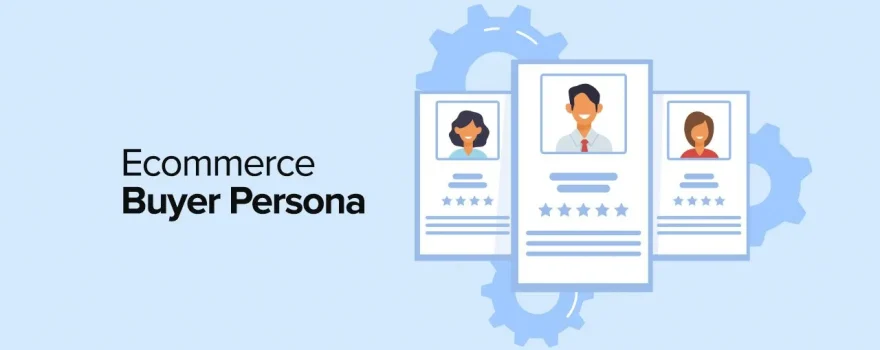
If you’re a marketer or business owner, you’ve probably come across the term “Buyer Personas” several times when reading articles, watching videos or listening to podcasts.
We also use the term in almost all marketing topics. And, just to be clear, it’s not just another buzzword we like to throw around – it’s actually an incredibly useful tool that can help you communicate with your target audience more effectively.
So, if you want to understand buyer personas and why they’re important to an e-commerce business, you’ve landed on the right page. In this article, we’ll dive into the topic and walk you through the process of creating buyer personas for your business.
Ready? – Let’s get started.
What is a buyer persona?
A buyer persona is a fictional character that represents the ideal customers for your products. It is created based on research of existing customers who use your products because you want to acquire and serve similar customers.
The buyer persona includes all the details that can influence the purchase decision of a particular type of customer. It can include their likes, dislikes, profession, pain points and goals along with their demographics (age, gender, location, etc.)
You can have multiple buyer personas based on your products and the types of eaters you want to target. It’s also called a customer persona or marketing persona,
Remember that customer personas represent your customer models. So, you should think of them as your real customers who may be interested in your products. For convenience, you can also give each persona names like Geeky Goerge, Lazy Lilly, etc,
Why does e-commerce need buyer personas?
In e-commerce, buyers play a crucial role in almost every aspect of business.
Product Research: You may find if a particular product meets the needs of at least one of your personas. If not, you can abandon the product idea immediately.
Marketing: Does your marketing campaign address pain points and challenges for any persona? If not, you can reconsider it. Similarly, you can use personas to create effective marketing strategies for all kinds of customers.
Customer service: Instead of giving generic answers to every customer, customer personas can help you identify a particular customer’s problems and solve the problem more effectively.
Fulfillment: You can choose the closest fulfillment and warehousing center to provide faster delivery services to your ideal customers.
Post-purchase: Based on the buyer’s personality, you can create relevant messages and offers to convert new customers into loyal ones.
Bottom line, if you want to understand your customers to provide the best customer experience at every stage of their purchase journey and beyond, you need a clearly defined buyer persona for your online store.
Steps to create a buyer persona for e-commerce
As mentioned earlier, buyer personas are supported by data. So instead of creating random personas, here’s the right you to create buyer personas for e-commerce businesses
Analyzing customer data
First, if you already have an online store, start collecting data on your existing customers. You can dig into your customer data to find details such as –
Aging
Gender
Location
Product interests
Purchasing power
And more based on the data you collect from your customers…
You can also use website analysis tools and market campaign data to gather more data about the type of users visiting your site and those participating in your marketing campaigns.
Survey your customers.
Next, you want to know your customers’ likes, dislikes, preferences, and other personal and professional data that can help you better understand them.
The best way to get this information is to interact directly with customers through questionnaires or individual phone calls. In doing so, you can start by asking the following questions
How did you discover our brand?
What are the biggest problems our products solve for you?
Why do you buy our products compared to other brands?
Do you use online research before you buy? If so, how do you search for information?
What are your hobbies and interests?
Do you need the approval of others to make purchasing decisions?
How do you spend most of your time?
What kind of social media do you prefer?
How do you prefer to communicate?
The goal of your customer surveys is to learn more about their interests, concerns and pain points that may influence their buying decisions. So make sure you’ve curated a list of relevant questions – keep it specific, direct and easy to answer.
Interview your customer service teams.
No one can give you more information about your customers than those who interact with them on a daily basis – your sales and customer service teams.
By interviewing them, you can find common objections that salespeople have to deal with and what customers expect from your brand in terms of service, product quality and more.
Here are some questions you can ask during the interview –
Reasons why customers don’t buy from us
Reasons why customers buy our products
What are the most common questions customers ask before they buy?
What are the most common questions customers ask after they buy?
How can we improve their shopping experience on our website?
Create your buyer personas
Now you should collect enough data that you can use to compile and identify common attributes among different types of customers.
So, at this point, you should create several groups of customers with common characteristics such as age, gender, pain points, locations, etc. These groups are your clients.
For example, let’s say you’ve identified a group of female customers, ages 25-30, who are tech-savvy, big spenders based in London.
This could be one of your customers.
Finally, you need to name the persona and give her a face, for which you can use stock images or your teammates (pun intended!)
Once you’ve figured out every detail, you create an attractive persona using the Semrush Free Persona Builder. You just need to select a template and enter all the details in the appropriate fields, as shown below –
Sample Buyer Persona.
Ready to create buyer personas for your store?
Like any business in e-commerce, you sell products to different types of customers. Since you can’t communicate directly with every customer, you need buyer personas that represent them and their characteristics.
This helps you understand them on a deeper level and allows you to make decisions that may affect them in one way or another. From making decisions about website design, and social media signatures to adding new products to your online store, buyer personas can be your guiding light to stay focused on your ideal customers.
So, if you haven’t created buyers for your e-commerce business, create them now and make sure to share them with everyone who makes decisions in your organization.




